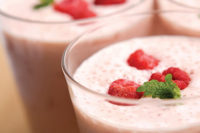Editor’s note: Alternative sweeteners, also known as sugar substitutes or sugar replacers, include both nonnutritive sweeteners (those with no or insignificant energy) and sugar alcohols, also known as polyols. Sweeteners approved for use in the U.S. are listed below.
A few years ago, I sampled single-serve smoothies at an educational event for families. Several parents picked up the product, saw an artificial sweetener on the label, and promptly put it back. A few said, “I don’t give my child anything with artificial sweeteners!” I explained the safety of artificial sweeteners, but these parents weren’t buying it.
Consumers are confused. “In terms of consumers’ desires, it’s hard to tell which sweetener is the best choice [for use in dairy products],” says Cara Kelly, director of strategy, insights and planning, Innovation Center for U.S. Dairy, Dairy Management Inc. (DMI). According to research conducted by Market Tree, Inc. for DMI (August 2011), many consumers aren’t sure which sweeteners are natural or artificial and view the sweeteners they believe to be artificial as bad for health. For details, log into USDairy.com. A white paper on consumer perceptions of sweeteners and dairy products will be posted in May.
“Consumers want it all: delicious taste, no calories and natural,” says Kelly. “Producers can use packaging to explain that a certain sweetener is natural or to emphasize health attributes. Dairy products have an advantage because consumers are willing to take on a few extra calories if the product is a rich in nutrients.” Kelly says consumers’ beliefs about alternative sweeteners warrant as much consideration during product formulation as other aspects such as taste and mouth-feel. “The take-home for processors is the check with their consumers.”
Thankfully, there are traditional and new sweeteners that may satisfy consumers who want it all. “Processors can think about using lactase to make products sweeter,” says David McCoy, PhD, vice president of product research, Dairy Research Institute, DMI. “This would also increase the market by appealing to lactose intolerant consumers.” McCoy also mentions Monk fruit (Tate & Lyle), a high-intensity sweetener derived from purified fruit juice, as an up-and-coming sweetener.
For technical considerations regarding use of sweeteners in dairy products, McCoy suggests consulting experts listed in the Research and Application Resources directory of the National Dairy Foods Research Center on USDairy.com.
Common "Approved" Sweeteners in the U.S.
| Nutritive | Non-Nutritive | |
|---|---|---|
| Natural |
Agave Juice Beet Sugar Brown rice syrup Cane sugar Corn sugar Corn syrup Dextrose Fructose High fructose corn syrup (HFCS) Honey Sucrose Sugar |
Stevia-derived sweeteners |
| Naturally-derived sugar alcohols |
Erythritol Maltitol Sorbitol Xylitol |
N/A |
| Artificial | N/A |
Acesulfame potassium (Ace K) Aspartame Saccharin Sucralose |
The term “natural” here is meant to indicate that the sweetener is derived from a plant source. Consultation with regulatory/legal expert is recommended before using “natural” in food labeling or advertising.



